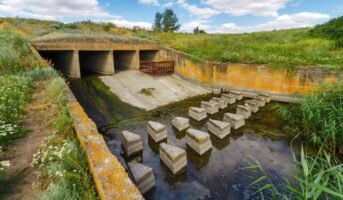Bamboo has been used for a variety of things, including building bridges. A renewable resource, bamboo is found in abundance in many parts of the world, including Southeast Asia, where bamboo bridges are a common sight. These bridges are generally constructed over rivers, streams or other waterways to offer a method of passage for bicyclists, walkers and even small automobiles.

Source: Pinterest
Bamboo bridge: Construction
A bamboo bridge is often built in several steps. Here is a general description of what happens:
- Site selection: When choosing a place for the bridge, take into account things like the width of the water body, the stability of the banks, and the expected volume of traffic.
- Choosing the right species of bamboo for the construction of the bridge. Some varieties of bamboo are renowned for their sturdiness and strength, which makes them perfect for structural uses. The bamboo poles’ diameter and length should be selected based on the bridge’s necessary load-bearing capacity.
- Building foundations: Building solid foundations on both sides of the water body is important. This can entail levelling the ground, clearing it of any trash, and making sure the bridge has a solid foundation.
- Frame construction: It is started by arranging the bamboo poles parallel to one another, stretching from one bank to the other, to form the primary frame of the bridge. There should be little space between the poles when they are placed close together.
- Lashing and fastening: The bamboo poles are fastened together using ropes or strong, natural fibres. To ensure that the structure is stable, these lashings should be tight and solid. For this, wire ties or conventional knotting methods can be employed.
- Support: Adding more bamboo poles in a diagonal or horizontal pattern will stabilise and strengthen the construction. These braces aid in an even load distribution and guard against excessive swaying or drooping.
- Decking: The bridge is given a layer of decking for a smoother surface. By laying bamboo boards or planks across the primary framework, this can be accomplished. To the bamboo framework, the decking must be firmly fastened.

Source: Pinterest
Bamboo bridge: Uses
Common applications for bamboo bridges include:
Pedestrian bridges: In rural and remote places, pedestrians might use bamboo bridges to traverse rivers, streams, or ravines. They enable individuals to gain access to crucial services, including hospitals, marketplaces, and educational institutions.
Bicycle bridges: Bicycles may fit on bamboo bridges, enabling bikers to cross bodies of water or challenging terrain. For bikers in rural locations, these bridges offer communication and transportation alternatives.
Footbridges for livestock: Bamboo footbridges can be made to allow for the transportation of animals like cattle or goats. They make it easier for animals to cross bodies of water, providing better access to grazing regions or markets.
Access to farms and fields: Bamboo bridges are frequently used to allow access to farms and fields that may be situated across rivers or streams. They make it possible for farmers to move cattle, crops, and equipment more effectively.
Recreational purpose: Bamboo bridges can be used in eco-tourism initiatives or recreational areas for both commercial and non-profit reasons. They preserve the surrounding natural environment while adding a distinctive aesthetic appeal and giving guests an immersive experience.
Disaster resilience: Bamboo bridges provide a lightweight, adaptable substitute for conventional bridges in places vulnerable to natural catastrophes like earthquakes or floods. After a disaster, they can be quickly built or rebuilt to reestablish vital transit linkages.
Sustainable infrastructure: Bamboo bridges are an example of sustainable infrastructure because they make use of renewable resources. Bamboo is an environmentally beneficial alternative to traditional bridge materials like steel or concrete because it uses less energy and resources during construction.
Craftsmanship and design: Bamboo bridges can be constructed as artistic or cultural works that highlight conventional craftsmanship and design. They act as cultural icons and popular tourist destinations, drawing people who are interested in native architectural styles.

Source: Pinterest
FAQs
Are bamboo bridges secure in the presence of heavy currents or floods?
In some cases, bamboo bridges are made to resist floods and powerful currents. They can adjust to the flow of the water thanks to their flexibility and lightweight. However, many elements, such as the design, the calibre of the construction, and maintenance, affect how safe the bridge is under adverse conditions.
Can bamboo bridges be constructed in cities?
Although they are more frequently encountered in rural or natural environments, bamboo bridges can also be built in cities. Urban bamboo bridge projects could also need to take things like building regulations, permits, and infrastructure integration into account. Bamboo bridges, however, can be used as distinctive and environmentally friendly architectural features in metropolitan environments.
| Got any questions or point of view on our article? We would love to hear from you. Write to our Editor-in-Chief Jhumur Ghosh at [email protected] |
Housing News Desk is the news desk of leading online real estate portal, Housing.com. Housing News Desk focuses on a variety of topics such as real estate laws, taxes, current news, property trends, home loans, rentals, décor, green homes, home improvement, etc. The main objective of the news desk, is to cover the real estate sector from the perspective of providing information that is useful to the end-user.
Facebook: https://www.facebook.com/housing.com/
Twitter: https://twitter.com/Housing
Email: [email protected]











